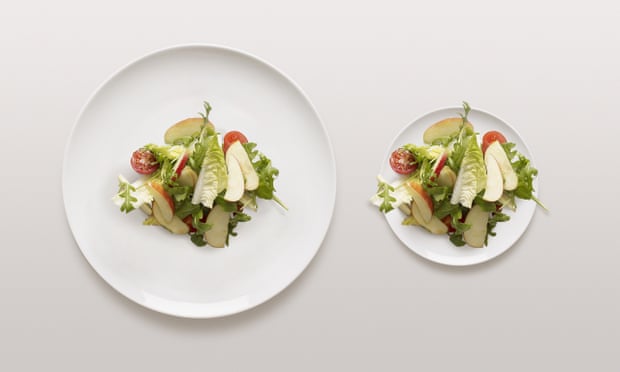Trick your brain
There are a couple of easy changes you can make that can have a profound effect on satiety – how full you feel. Research shows that using smaller crockery tends to trick our brains into believing we are eating more, a psychological phenomenon that can best be illustrated by taking a look at the Delboeuf optical illusion.
If you put two identical portions of food on a big plate and a small plate, the portion on the bigger plate will look smaller, and vice versa: our brains can’t help but be fooled by this effect, even when we know they are the same.
We also know that serving food in a bowl instead of on a plate can give the food a greater sense of volume and depth, yet again tricking our brains into thinking there is more there than is actually the case. The latest research shows that the weight of cutlery and crockery has a significant effect on our appreciation for meals we eat; with heavier plates and knives and forks offering greater levels of satiety.
So what’s the take-away from all of this? Serve your meals in small, heavy bowls and eat with heavy cutlery!
Make it difficult to eat
This may seem a little ridiculous, but research shows that if we are forced to eat with a non-dominant hand we’ll generally consume less. But this isn’t necessarily going to make your experience of eating any more pleasant. So, instead, try using other creative ways to enjoy interacting with your food, such as using Japanese soup spoons to eat your soup, or chopsticks for other foods – anything, in fact, that stops you from simply shovelling food into your mouth. Mindful eating is key here.
No more TV dinners
We just mentioned mindfulness and it would appear that this is a major contributor to how well and how much we eat. Research shows that we consume as much as 30% more when we’re engaged in other activities, such as watching television.
Such distractions are becoming far more commonplace at the dining table. In fact many people don’t even use their dining space at home, preferring to eat in front of the TV or looking at phones. However, messaging and checking social media are surefire ways to ensure you’re not focused on the food you are eating; you’ll appreciate your it less, which inevitably results in both a reduced sense of satiety and overeating.
So the advice here is to turn off the TV, put the phone on charge in the other room and sit at a dining table to fully enjoy your meal.
Eat with all your senses
In our Kitchen Theory dining experiences we introduce dishes with weird sensory elements – getting people to eat while enhancing other senses, such as smell or sight. But multisensory dining is about more than that. At the core of what we do is the idea of helping people to be truly mindful of the dishes that they are presented with.
Holding a warm bowl in your hand also helps, as does chewing properly (your mum was right …) and exhaling as you chew – this stimulates the olfactory receptors and further enhances the flavour of food. Finally, focus on the texture. It’s interesting to note that we consume fewer calories when eating apples than we do with apple puree, and fewer calories with apple puree than apple juice because we get more sensation information from the puree than the juice, more still from the actual apple. In other words, our brains use the amount of sensation we receive from texture as one of the cues to tell us when to stop eating.At home this can be as simple as taking a moment before eating to sniff your food and really appreciate the aromas. (Many researchers believe that up to 90% of what we perceive as flavour comes from our sense of smell.)
Source : The guardian






0 on: "How to trick your brain into healthy eating"